Wind energy for rural America was an engaging topic during the educational session, “Harvesting the Wind,” held yesterday during the AG CONNECT Expo. The session provided an outlook for the wind energy industry in the states as well as offered information on projects suited for rural areas, such as farmers leasing out their land to companies to site windmills. The session was sponsored by 25×25, a nonprofit organization that believes our country can get 25 percent of our energy through renewable sources by 2025.
 Presenters included Lisa Daniels, Executive Director and founder of Windustry, a nonprofit organization that specializes in developing community wind projects. These types of projects are owned by local members of the community and private investors, not wind turbines owned by a utility company. In addition, Steve Wegman, Director of South Dakota Wind Energy Association discussed how his organization is helping South Dakota increase its wind energy through rural projects, and Susan Sloan, Manager, Strategic Partnerships for the American Wind Energy Association (AWEA), provided an industry overview that included current and proposed policy and programs to increase wind energy throughout the U.S.
Presenters included Lisa Daniels, Executive Director and founder of Windustry, a nonprofit organization that specializes in developing community wind projects. These types of projects are owned by local members of the community and private investors, not wind turbines owned by a utility company. In addition, Steve Wegman, Director of South Dakota Wind Energy Association discussed how his organization is helping South Dakota increase its wind energy through rural projects, and Susan Sloan, Manager, Strategic Partnerships for the American Wind Energy Association (AWEA), provided an industry overview that included current and proposed policy and programs to increase wind energy throughout the U.S.
A few interesting statistics that were shared during the session: the wind energy industry added an estimated 35,000 jobs last year; wind emits no CO2 and uses no water; and today the wind energy industry has the capacity to generate 31,000 megawatts of wind per year. One megawatt generates enough electricity to power 225-300 homes per year.
In 2008, the U.S. Department of Energy authored a report called “20% Wind Energy by 2030,” that is currently being used by the Obama administration for guidance on growing the wind industry. A copy of the report is available at www.20percentwind.org, and don’t forget to visit our AG CONNECT Flickr album.

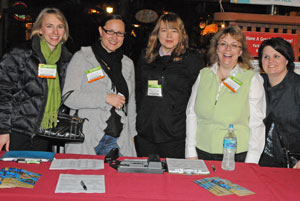 Here’s the happy smiley greeting crew for
Here’s the happy smiley greeting crew for  Well, we’re in the home stretch. It’s the final day of AG CONNECT Expo and the temperatures are supposed to be in the 70’s today! I’ll be back out on the show floor today along with Joanna Schroeder conducting interviews and hope to have a wrap up interview from show staff by the end of the day.
Well, we’re in the home stretch. It’s the final day of AG CONNECT Expo and the temperatures are supposed to be in the 70’s today! I’ll be back out on the show floor today along with Joanna Schroeder conducting interviews and hope to have a wrap up interview from show staff by the end of the day. A year ago would you have thought you’d see this proudly displayed in an agribusiness booth?
A year ago would you have thought you’d see this proudly displayed in an agribusiness booth? Precision agriculture technology is on display all over the AG CONNECT Expo show floor. I don’t think I’ve seen quite so many exhibits outside of a show dedicated to this growing technology application. Raven Industries is one of the companies exhibiting something new here at the show.
Precision agriculture technology is on display all over the AG CONNECT Expo show floor. I don’t think I’ve seen quite so many exhibits outside of a show dedicated to this growing technology application. Raven Industries is one of the companies exhibiting something new here at the show. Discussing the future of agricultural communications was the job of Orion Samuelson, Jim Evans and Mike Yost today at AG CONNECT Expo. Jim has spent a lifetime in agriculture and Ag communications, as a practitioner and professor at the University of Illinois. The panel took place in Successful Farming’s Innovations Theater where they’ve been doing
Discussing the future of agricultural communications was the job of Orion Samuelson, Jim Evans and Mike Yost today at AG CONNECT Expo. Jim has spent a lifetime in agriculture and Ag communications, as a practitioner and professor at the University of Illinois. The panel took place in Successful Farming’s Innovations Theater where they’ve been doing  ve video displayed simultaneously. The news about the Matrix Guidance System with RealView Guidance Over Video was announced during the
ve video displayed simultaneously. The news about the Matrix Guidance System with RealView Guidance Over Video was announced during the  My Alma Mater was out and about at AG CONNECT Expo today. Here are three ag comm students from The University of Florida. They were watching this afternoon’s panel discussion in the Innovations Theater on the future of ag communications. I’ll have more on that later.
My Alma Mater was out and about at AG CONNECT Expo today. Here are three ag comm students from The University of Florida. They were watching this afternoon’s panel discussion in the Innovations Theater on the future of ag communications. I’ll have more on that later.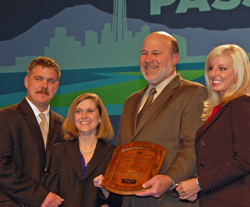 Scott and Mendy Sink of Virginia won the Excellence in Ag Award. They received a 2010 Dodge Ram pickup, courtesy of Dodge, and free registration to the YF&R Leadership Conference in Oklahoma February 20-22. The Excellence in Ag award recognizes young farmers and ranchers who do not derive the majority of their income from an agricultural operation, but who actively contribute and grow through their involvement in agriculture, their leadership ability, and participation in Farm Bureau and other organizations. We were especially proud that farm broadcasters Andy Vance and Lindsay Hill were in the top ten finalists for that award.
Scott and Mendy Sink of Virginia won the Excellence in Ag Award. They received a 2010 Dodge Ram pickup, courtesy of Dodge, and free registration to the YF&R Leadership Conference in Oklahoma February 20-22. The Excellence in Ag award recognizes young farmers and ranchers who do not derive the majority of their income from an agricultural operation, but who actively contribute and grow through their involvement in agriculture, their leadership ability, and participation in Farm Bureau and other organizations. We were especially proud that farm broadcasters Andy Vance and Lindsay Hill were in the top ten finalists for that award.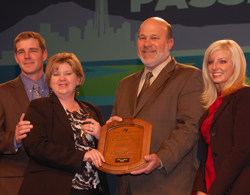 Aaron and Ashley Reding of Kentucky won the Achievement Award which recognizes young farmers and ranchers who have excelled in their farming or ranching operations and exhibited superior leadership abilities. They also won a 2010 Dodge Ram Pickup courtesy of Dodge and paid registration to the 2010 AFBF YF&R Leadership Conference.
Aaron and Ashley Reding of Kentucky won the Achievement Award which recognizes young farmers and ranchers who have excelled in their farming or ranching operations and exhibited superior leadership abilities. They also won a 2010 Dodge Ram Pickup courtesy of Dodge and paid registration to the 2010 AFBF YF&R Leadership Conference.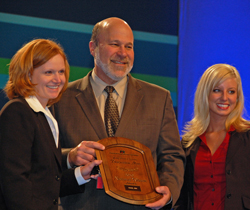 Last, but not least, Rachel Bina of North Dakota won the Discussion Meet. She also gets a new Dodge pickup and registration to the conference. The Discussion Meet simulates a committee meeting in which active discussion and participation are expected. Participants are evaluated on their ability to exchange ideas and information on a predetermined topic.
Last, but not least, Rachel Bina of North Dakota won the Discussion Meet. She also gets a new Dodge pickup and registration to the conference. The Discussion Meet simulates a committee meeting in which active discussion and participation are expected. Participants are evaluated on their ability to exchange ideas and information on a predetermined topic.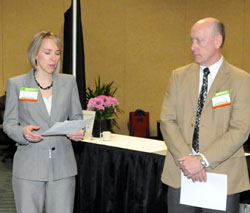 AG CONNECT Expo released some statistics about the show this morning during a press briefing. We heard from Show Director Sara Mooney and AEM VP of Ag Services, Charlie O’Brien.
AG CONNECT Expo released some statistics about the show this morning during a press briefing. We heard from Show Director Sara Mooney and AEM VP of Ag Services, Charlie O’Brien.  According to a
According to a